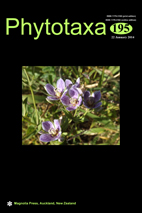Abstract
Archilejeunea (Spruce 1884: 88) Stephani (1888: 113) is a pantropical genus with about 28 species in two subgenera, subg. Archilejeunea with five species and the remaining ones in subg. Dibrachiella (Spruce 1884: 90) Schiffner (1893: 130) (Gradstein & Buskes 1985). The genus has been well-studied in the Neotropics and Australia (Gradstein & Buskes 1985; Thiers & Gradstein 1989; Gradstein 1994; Gradstein & Schäfer-Verwimp 2012) but the treatments of the African and Asiatic species are incomplete or outdated (e.g., Stephani 1911; Verdoorn 1934; Vanden Berghen 1951; Udar & Awasthi 1981a, 1982; Mizutani 1993; Gradstein et al. 2002). Several species have not been studied since their first publication. Moreover, recent molecular-phylogenetic studies indicate that Archilejeunea is not monophyletic (Wilson et al. 2007). Members of A. subg. Archilejeunea were resolved in a clade with Caudalejeunea (Stephani 1890: 18) Schiffner (1893: 129) and Schiffneriolejeunea Verdoorn (1933: 89), while those of A. subg. Dibrachiella resolved in a distant clade with species of Spruceanthus Verdoorn (1934: 151) and Ptychanthus Nees (1838: 211). As a result, the genus urgently needs revision.

